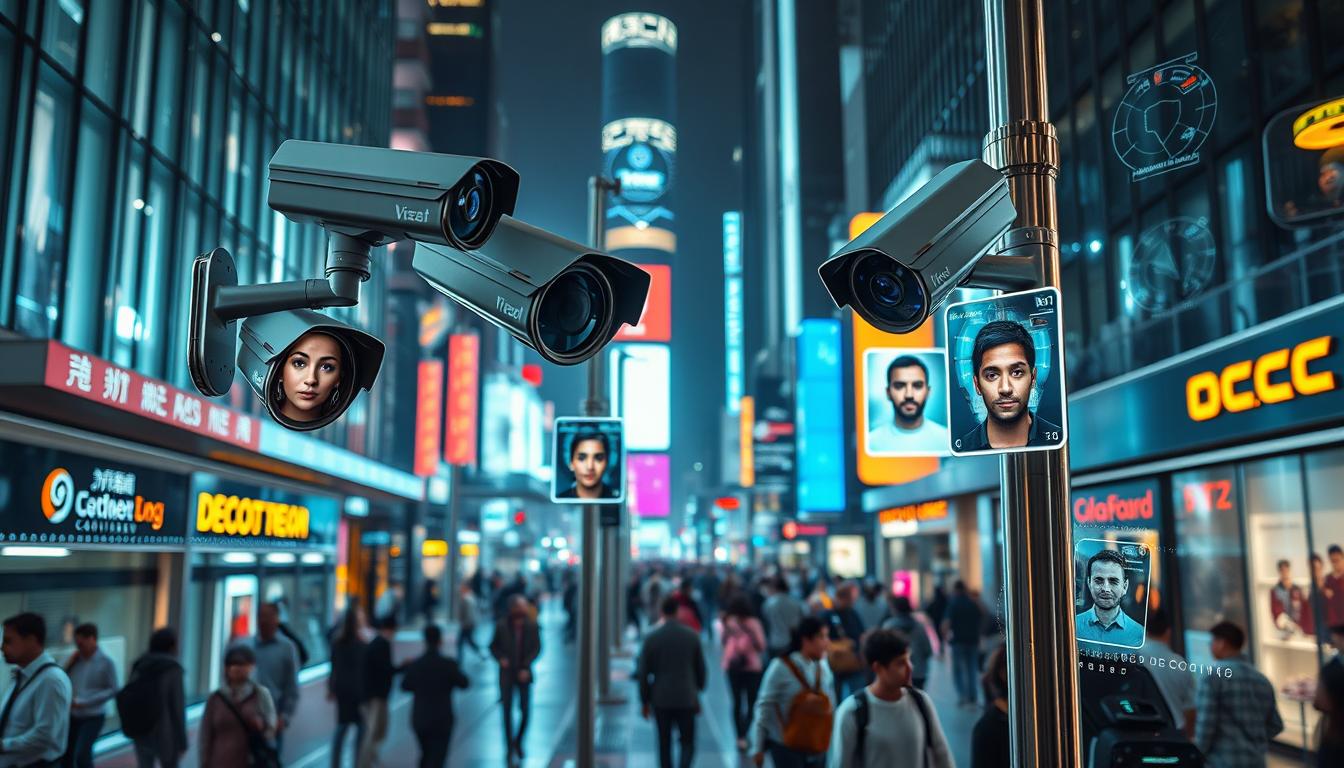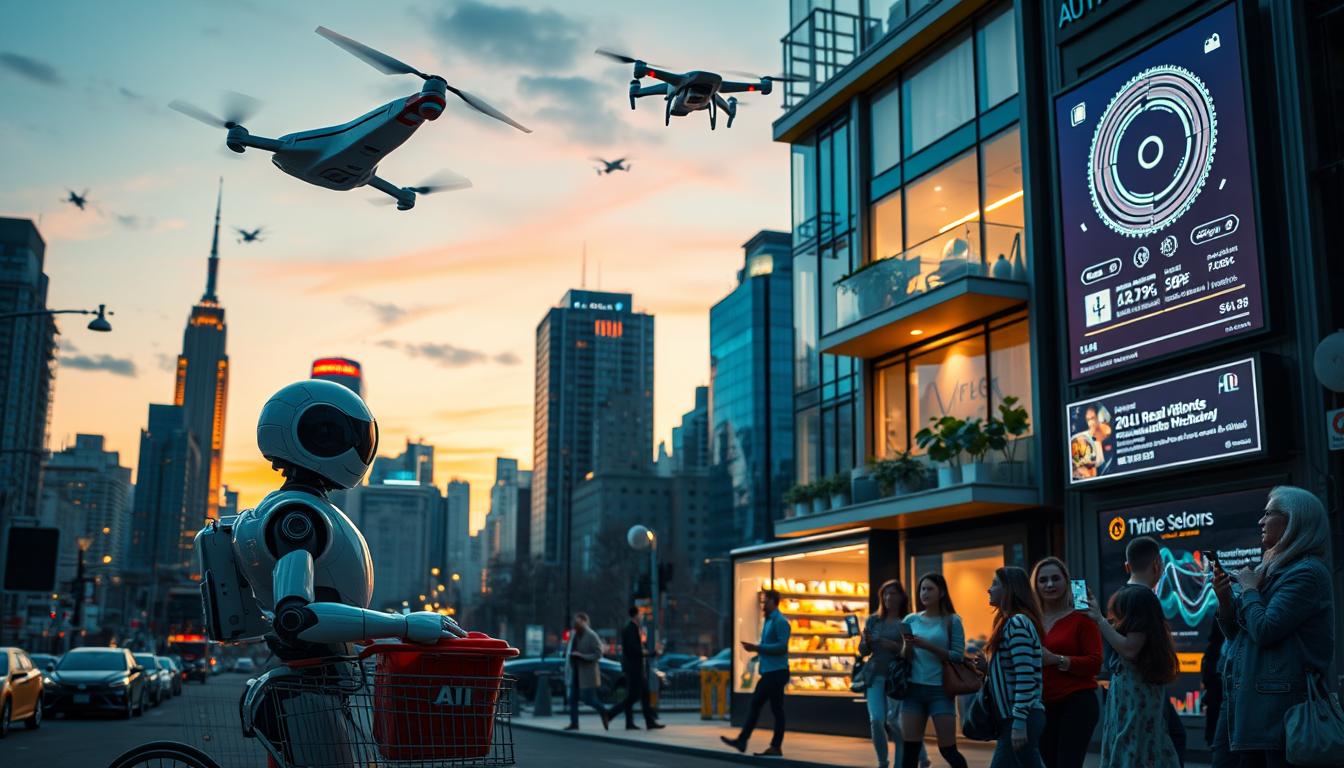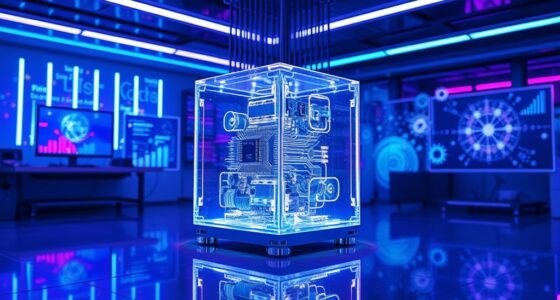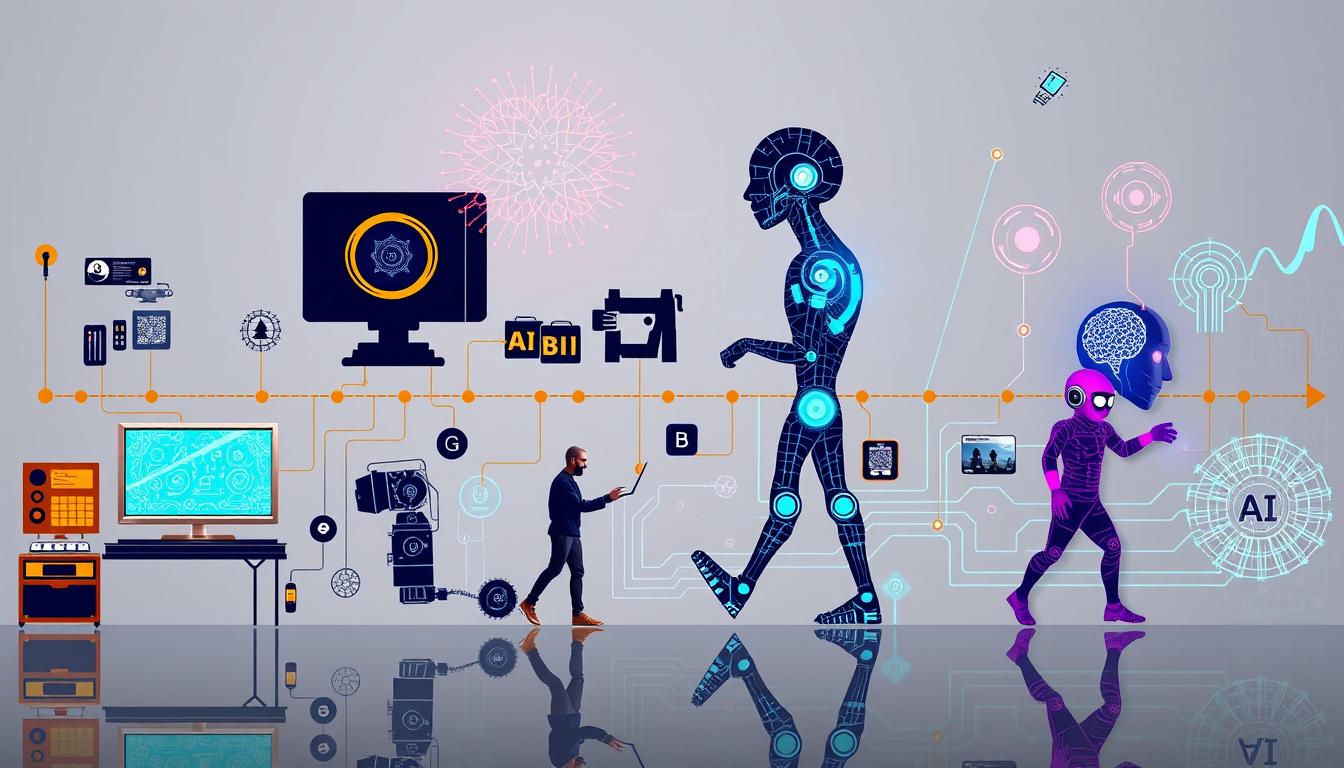Have you ever felt anxious in a crowded place, wondering about safety? Imagine you’re walking or at a concert. Behind the scenes, advanced AI is working to keep us safe. AI facial recognition technology is now a key tool for *law enforcement*. It changes how officers track criminals and make our spaces safer. By looking at facial features and searching huge databases, this tech helps spot suspects quickly. It’s making a big difference in *tracking criminals* and stopping dangers we couldn’t before.
This *identification technology* makes police work more efficient and gives us peace of mind. As AI becomes part of public viewing, it aims to prevent crime with fast actions. Every face caught by cameras and drones is a step towards a safer place. But as we appreciate these steps forward, we must think about the challenges and ethics of *surveillance technology*.
Key Takeaways
- The majority of law enforcement agencies are now leveraging AI facial recognition technology to enhance safety and security.
- AI facial recognition serves as a reliable tool in identifying suspects involved in fraud and identity theft.
- Real-time capabilities allow for quicker responses and potentially prevent crimes before they escalate.
- AI systems can analyze data from various sources, including documents and real-time footage, to identify individuals.
- Ethical concerns regarding privacy and accuracy in identification continue to be significant challenges.
Introduction to AI Facial Recognition Technology
Artificial Intelligence is changing how we stay safe, especially with facial recognition introduction. This tech compares faces to identify people, helping prevent and solve crimes. Law enforcement uses it to watch over areas and quickly find suspects.
The use of AI technology in recognising faces is catching eyes worldwide. Agencies in Western and South-Asian countries started using it recently. In 2016, INTERPOL unveiled the Facial Recognition System. It has a huge database for finding criminals across borders. This helps in everything from finding missing people to spotting terrorists. Thousands have been identified thanks to this system.
But, privacy and ethical worries are also important. With companies like Clearview AI being accused of breaking privacy laws, tension is rising. As this tech advances, it’s crucial to keep privacy safe.
The review of AI technology overview in face recognition shows its good and bad sides. It’s changing how the police work and how we interact. How we deal with its effects will decide its future.
Understanding Facial Recognition Technology
Facial recognition technology has evolved greatly. It uses advanced methods to better identify people in different areas. It scans unique facial features to match with a large database.
This technology is now very adaptable. It works well even when light changes or from different angles. This adaptability is key for work in security and law enforcement.
Think about this – a study by Georgetown Law in 2013 found that nearly 4,000 of over 15,000 law enforcement agencies had facial recognition capabilities. This shows how much it’s being used.
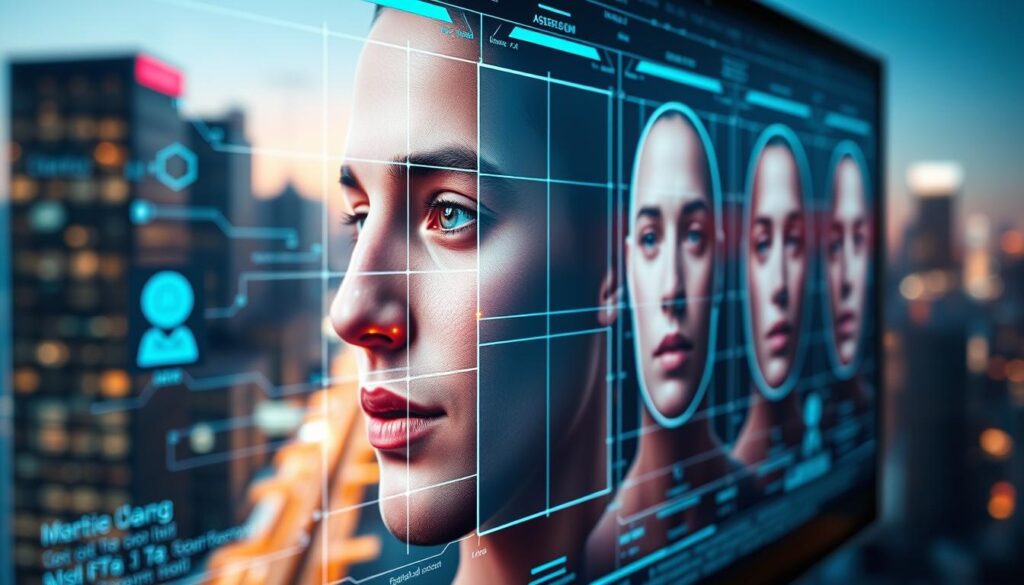
More agencies using facial recognition means a smarter identification process. A study by NIST found accuracy rates vary from 36% to 87%. It depends on factors like where the camera is placed.
Understanding facial recognition and how it identifies people is important. It’s crucial for its use in tracking criminals and monitoring security effectively.
How AI Facial Recognition is Revolutionizing Law Enforcement
The AI impact on policing is clearly seen as facial recognition changes law enforcement work. It allows police to quickly identify people, speeding up the process in new ways. Traditional methods like fingerprinting just can’t keep up.
Veritone’s Intelligent Digital Evidence Management System (iDEMS) is at the forefront of this shift. It improves how law enforcement analyzes and manages multimedia evidence, helping detectives work more effectively. Veritone Track makes it easier to analyze videos from various sources, ensuring personal information stays safe.
Technology uses human-like objects (HLOs) to identify people based on things like hats or clothing logos. This method reduces bias and protects identities. Agencies in Thailand and the UK benefit from it, with North America catching up fast.
Working with top tech companies like AWS and Deloitte, these law enforcement tools focus on being ethical and trustworthy. By 2025, the goal is for officers to have even more tech tools. They’ll have body cameras, fleet cameras, city surveillance, and drones to help keep public places safe. These advancements aim to enhance transparency and accountability while protecting individual privacy rights. With leading tech firms driving innovation, these tools will integrate real-time data analytics to assist officers in making quicker, informed decisions. Much like john ashton’s notable film roles often showcasing law enforcement, the future holds an intersection of technology and policing that promises to reshape how public safety is maintained.
The Oakland Police Department shows how well advanced analytics can work. Between 2012 and 2019, they cut shootings by 50% and homicides by 42%. This huge drop in crime shows the power of these technologies.

Benefits of Using AI in Tracking Criminals
AI facial recognition tech brings many advantages for finding criminals faster. It’s 96% better at spotting suspects than old methods. This big jump helps officers locate people very quickly.
This tech also helps prevent crimes before they happen. AI systems can notify police about unusual activities right away. This early warning has helped cities cut crime rates by 40%.
AI speeds up the process of identifying faces significantly. Law enforcement can solve cases 70% faster with it. Agencies that use AI solve 75% more cases quickly.
The accuracy of AI in pinpointing the right person is almost perfect at 99.6%. It also helps prevent prior offenders from committing more crimes by 50%. This makes communities safer for the long haul.

AI is improving and becoming useful in many areas, not just safety. Police departments using AI find it boosts public safety and trust. It’s a key tool for a better, safer community.
AI Facial Recognition is Being Used to Track Down Criminals
Artificial intelligence is changing how law enforcement finds and catches suspects. Now, officers can use real-time identification. This means they match faces to a database right as events happen. It makes reacting faster and solving cases more likely. More police are using AI to get better at tracking down criminals.
Real-time Identification of Suspects
Using AI helps detectives greatly in tracking suspects in violent crimes. In Miami, after starting to use AI in 2023, police solved 68% of murders and 58% of violent crimes. This was a big jump from 45% and less than 38% before AI. Detectives were 66% more likely to find suspects with AI. This shows how crucial real-time ID is today in fighting crime.
Integration with Surveillance Systems
Linking AI with surveillance cameras has changed how crimes are solved. This combo allows for the constant watching of many places. It helps spot criminals at events or in dangerous areas. Still, it’s important for police to think about privacy and ethics. There’s ongoing debate about how these techs affect civil rights, especially in less privileged groups.
![]()
| Crime Type | Before AI Implementation | After AI Implementation |
|---|---|---|
| Murder Resolution Rate | 45% | 68% |
| Violent Crimes Resolution Rate | 38% | 58% |
| Increased Chance for Detectives | N/A | 66% Greater Chance |
Challenges Faced by Law Enforcement Agencies
AI facial recognition tech has changed how police track crime. However, it’s not without problems. As it grows, officers must balance safety with personal freedoms.
Privacy Concerns and Ethical Implications
Many worry about their privacy with facial recognition tech’s rise. It sparks fears of being watched without consent. And 70% of Americans think it shouldn’t be used alone for arrests.
Ethical dilemmas appear due to AI’s biases. These can wrongly accuse people. It’s worse for communities of color, raising fears and tensions with the police.
False Positives and Identification Accuracy
Getting ID right is vital, but facial recognition isn’t perfect. False positives can unfairly impact innocent people. And 53% believe it could lead to more false arrests by police.
These mistakes can harm police reputation and public trust. So, the accuracy of this tech is crucial.
| Concern | Public Opinion |
|---|---|
| Privacy Concerns | 60% of Americans believe people should assume they are being monitored in public. |
| Ethical Issues | 66% think police would monitor certain neighborhoods more often. |
| Identification Challenges | 70% say facial recognition match shouldn’t lead to arrests. |
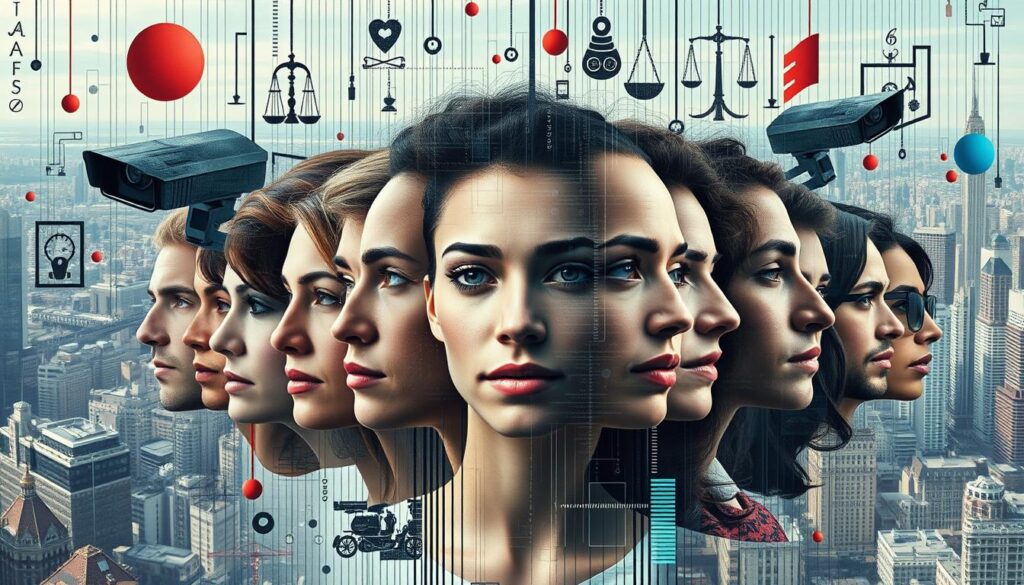
The Role of AI in Identifying Masked Criminals
Law enforcement needs help identifying masked individuals who threaten public safety. Advanced deep learning applications greatly improve this capability. They allow using powerful facial mapping to pick out key features, even if hidden. This transforms the resolution of cases, increasing the chances of catching criminals who might escape justice.
Deep Learning Techniques for Facial Mapping
Deep learning has changed the way facial recognition systems work. They measure distances and angles between facial features. These systems are good at figuring out identities, even when important features are covered. This technology helps identify masked people, making law enforcement more efficient and quicker in their response.
Case Studies of Successful Identifications
There are many success stories of AI helping law enforcement. Tools like Veritone IDentify have helped thousands of officers quickly identify suspects. This tech produces immediate results from evidence already collected. For example, the Anaheim Police Department caught a child abuser in one day using this system. This shows the power of AI technology in investigations. These cases show the value of AI in identifying masked people and suggest great potential for enhancing public safety in the future.
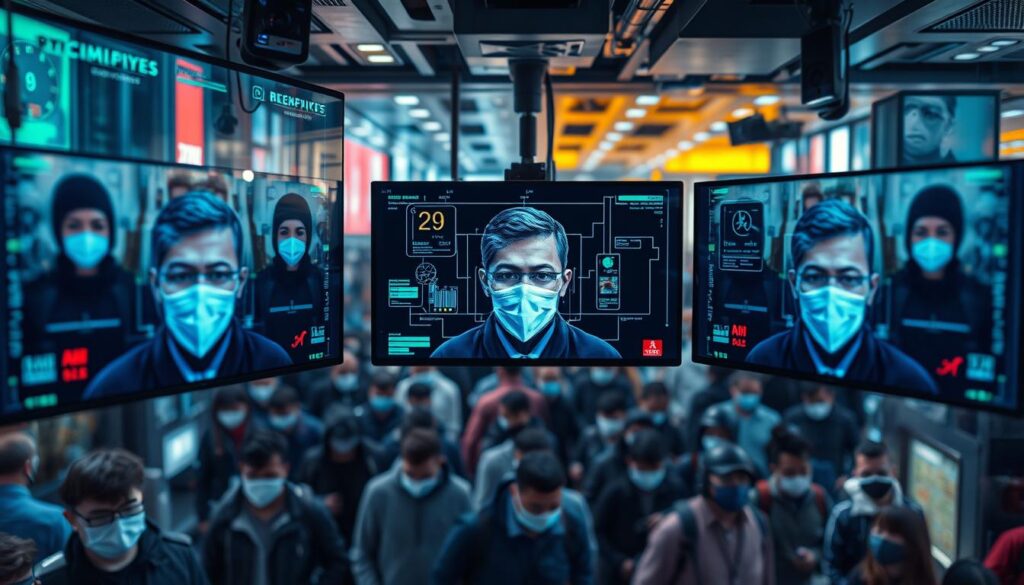
| Case Study | Identified Criminal | Method Used | Time to Resolution |
|---|---|---|---|
| Anaheim Police Department | Child Abuser | Veritone IDentify | 1 Day |
| London Police Operation | Masked Attendee | Real-time Facial Recognition | Immediate |
| Carnegie Mellon University | Obscured Suspect | Enhanced Detection Algorithms | Ongoing Development |
Combating Identity Theft with Facial Recognition Technology
Facial recognition technology is key in fighting identity theft today. It helps prevent fraud by checking if someone is who they say they are. This is done by looking at unique facial features. This technology is more secure than just using passwords or ID cards.
Detecting Fraudulent Identities
Facial recognition works fast and does not bother people. It turns facial details into a code called a faceprint. When someone tries to use a service, their faceprint is checked. This makes sure that only real people get accepted. This is very important in areas where keeping identities safe cuts down on theft risks.
Enhancing Driver Safety and Monitoring
This technology also increases road safety. It checks driver’s license pictures against their real faces. This stops those with bad driving records from driving. It creates safer roads and brings in safety steps against risks. As technology gets better, it’s a solid way to keep driving safe from identity thieves.
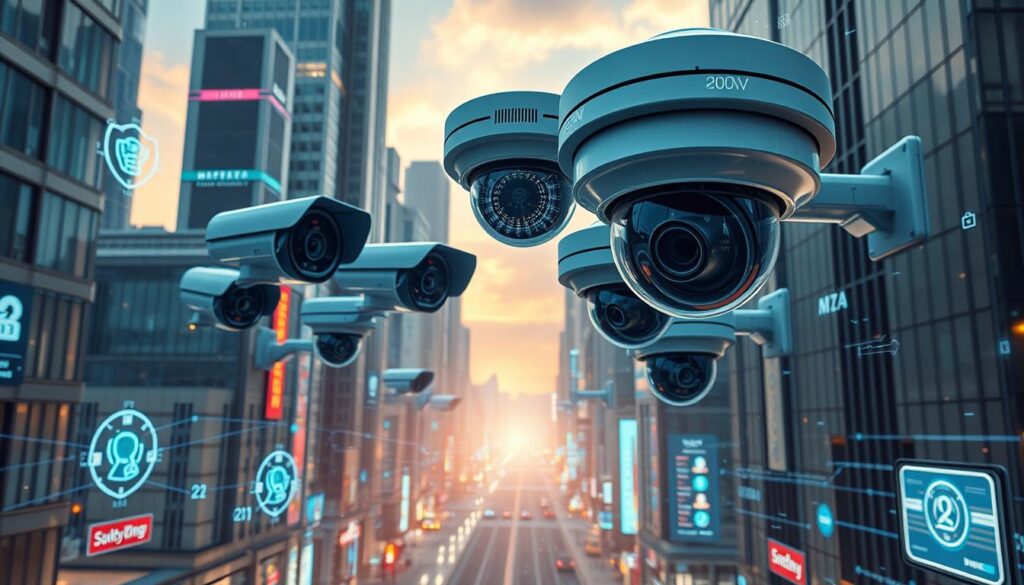
Adopting Standalone Devices for Facial Recognition
In the last few years, standalone facial recognition devices have become key for law enforcement. They bring powerful features that make identifying people more effective. These devices use top-notch technology to quickly capture and analyze faces.
These advancements help build large databases of facial details and expressions. This preemptive approach improves the identification process before incidents occur. By using these devices in public areas, law enforcement can identify suspects fast. This leads to quicker actions and safer communities.
Take a look at the following table, which highlights some critical features of various standalone devices:
| Device Model | Identification Speed | Resolution | Storage Capacity |
|---|---|---|---|
| Box Camera XYZ | Instant (within seconds) | High (4K resolution) | Up to 1,000,000 faces |
| Camera A123 | Fast (within 2 seconds) | Medium (1080p resolution) | Up to 500,000 faces |
| ProCam 9000 | Quick (within 1 second) | Ultra High (8K resolution) | Up to 2,000,000 faces |
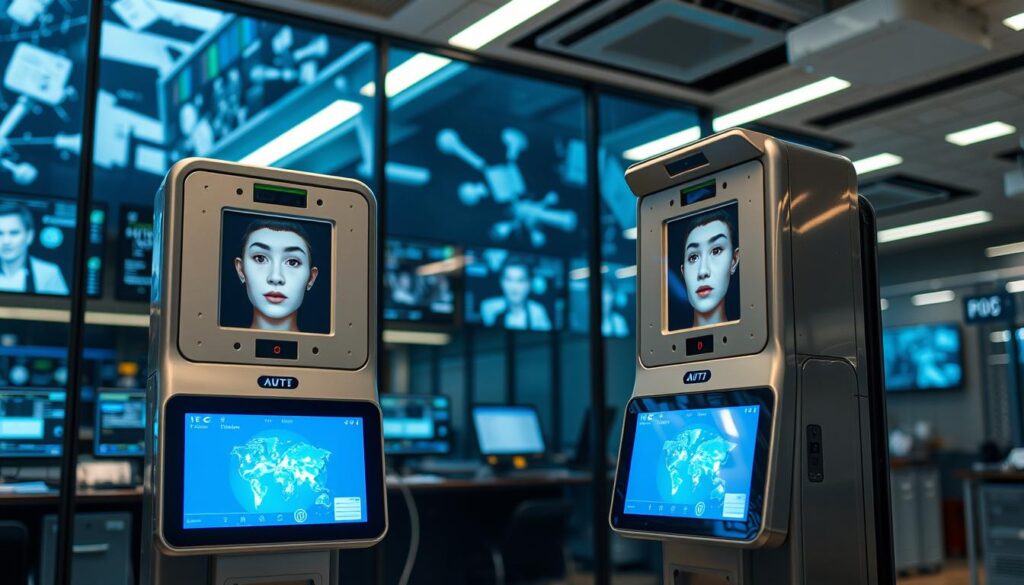
The trend of adopting technology is part of a bigger move to use advanced tools in law enforcement. Globally, as agencies start using these devices, the focus on being responsible and transparent increases. This ensures that their use is ethical and above board.
Technological Advancements in AI Facial Recognition
The landscape of artificial intelligence is changing fast, leading to big improvements in facial recognition. These advancements mean data can be processed in real-time better than ever. Law enforcement agencies use these systems to quickly look through lots of data. This helps them identify suspects almost right away. It speeds up criminal investigations and makes sure resources are used well, improving public safety.
Innovations in Real-Time Data Processing
Recent changes have made facial recognition technology work better. Now, these systems can handle images more quickly and with more accuracy. They also make fewer mistakes in identifying people. This matters a lot since Georgetown University Center says around half of all US adults are in law enforcement databases. Thanks to these improvements, over 3,000 police departments using Clearview AI have saved time and solved cases faster.
Future Trends in Surveillance Technology
In the future, we will see AI facial recognition used more in law enforcement. Many states are creating laws to manage how this technology is used. People are worried about their privacy and the ethical side of things. Thanks to better machine learning and image recognition, these systems will get even more reliable. As technology moves forward, we’ll likely see it used more for things like managing crowds and securing events. This means we can stop crimes before they happen.
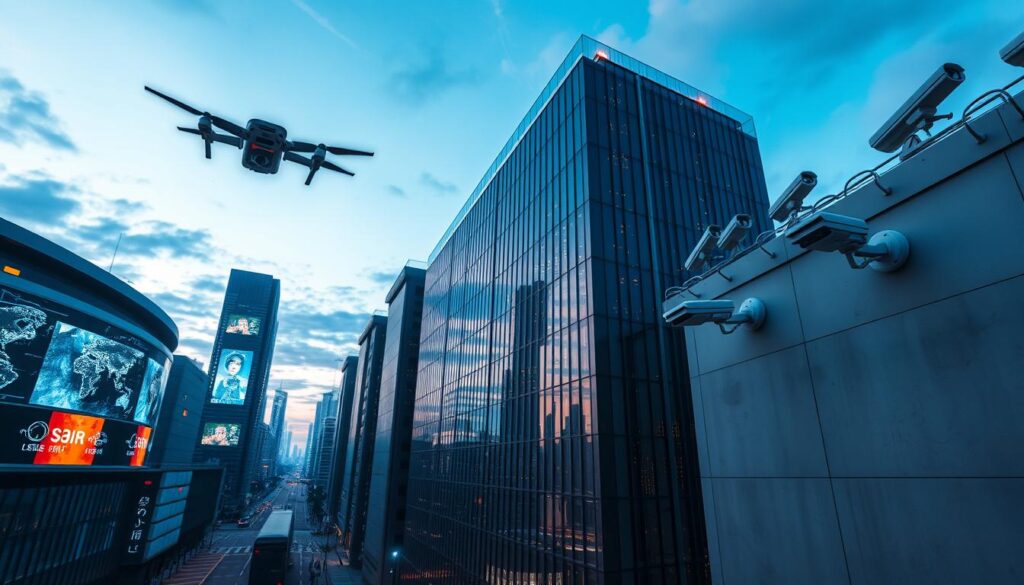
Public and Government Responses to AI Facial Recognition
The landscape surrounding facial recognition technology has become increasingly complex, prompting shifts in public opinion and governmental response. Many in society view these technologies as potential advancements in security measures. Others raise concerns about privacy and surveillance ethics.
Governments are looking closely at facial recognition technology policies. Testing by the National Institute of Standards and Technology (NIST) has uncovered racial disparities in performance. This raises fairness issues. Studies by Dr. Joy Buolamwini and Dr. Timnit Gebru show problems with gender classification. They find algorithms often misclassify women with darker complexions.
Public opinion on facial recognition varies widely. Some advocate for its use to enhance security, particularly after incidents of civil unrest. Critics, however, point out the risks of misuse. A notable example is Nijeer Parks, a Black man who spent ten days wrongly jailed because of a facial recognition mistake.
To address these concerns, lawmakers are advocating for stricter rules. They suggest setting performance standards for algorithms law enforcement uses. Several U.S. cities and counties have already banned government use of facial recognition. The ACLU is urging a federal moratorium on its use in law enforcement and immigration enforcement.
The debate over facial recognition technology policies continues. The demand for accountability and transparency is growing. Many insist on measures to protect civil liberties against these technologies.

| Key Findings | Implications |
|---|---|
| NIST Testing Results | Persistent racial disparities in accuracy |
| Research by Buolamwini and Gebru | Gender classification issues for darker complexions |
| ACLU of Northern California Testing | False matches with Congress members |
| Lawmakers’ Proposals | Need for performance scores and regulations |
| City Bans | Prohibition of government use of technology |
| ACLU’s Federal Moratorium Call | Request to halt usage by law enforcement |
Conclusion
AI facial recognition tech is growing fast, offering lots of chances for law enforcement. This tech helps catch criminals more effectively, making communities safer. With success rates up to 96%, its impact is clear. But, we must think about privacy and fairness too.
The way technology and society mix is complicated. Research shows facial recognition doesn’t work the same for everyone. This means we need to keep a close eye on it. Using this tech wisely is key to enjoying its benefits while protecting our rights.
Looking ahead, it’s vital to push for fairness and clear rules in AI facial recognition. With its market expanding, we all play a role in its direction. By backing ethical guidelines, we help build a fair and safe world for everyone.

